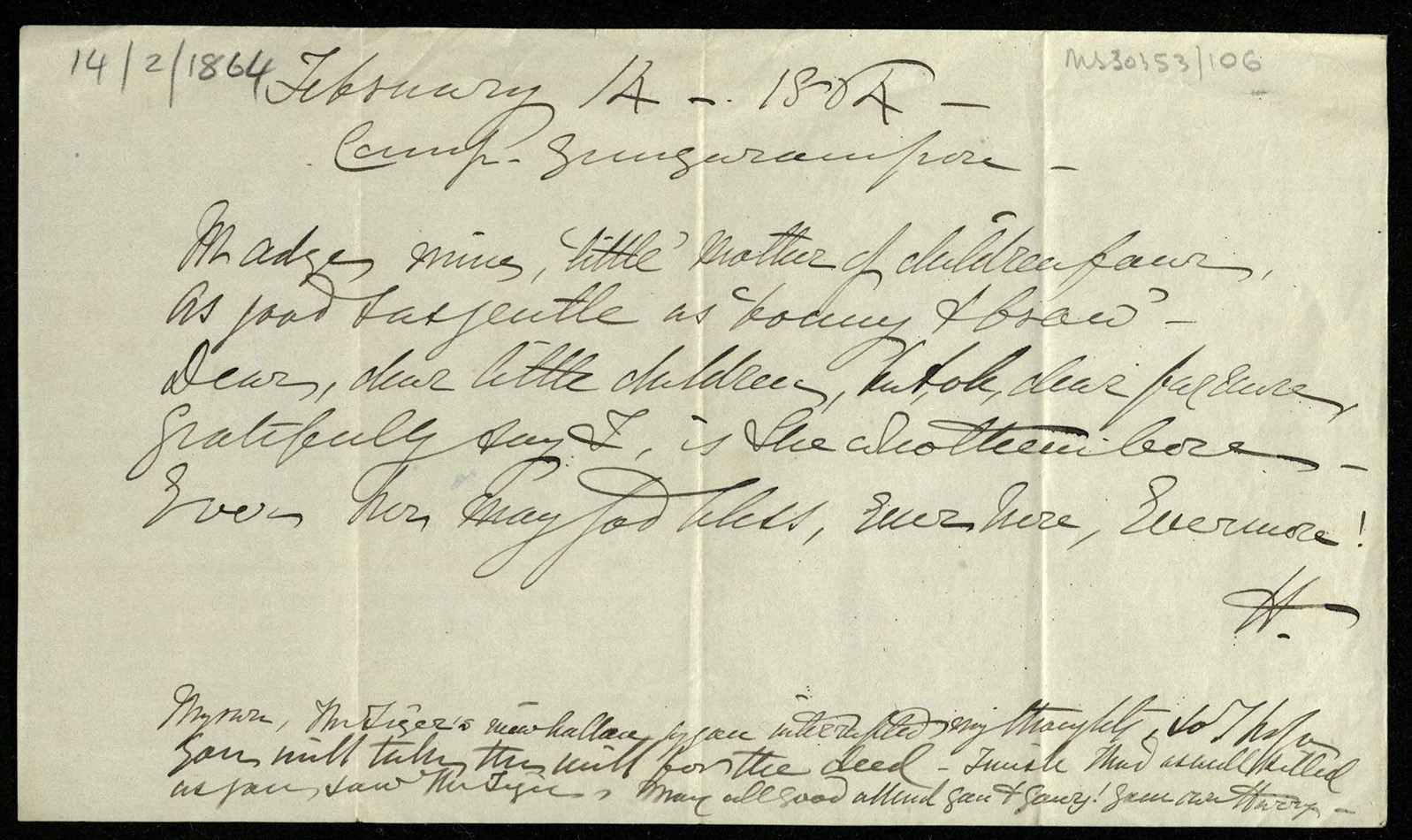Love and horse-racing in India

February 14
Dearest Madge, with your Husband and young Children three
May you ever be as Happy as Happy can be!
And whenever Adversity troubles your rest,
May it leave you better! For All is for the Best!
Yo HCamp, 1861

February 14 – 1864
Camp Gungarampore [Gangarampur]
Madge mine, ‘little’ mother of children four,
As good and as gentle as ‘bonny & braw’,
Dear, dear little children, but oh, dear far more
Gratefully say I, is She who them bore –
Ever her may God bless, ever here, evermore.
HMy own, the Tiger’s near hallao interrupted my thoughts, so I hope
you will take the will for the deed. I wish I had as well killed
As you saw the Tiger. May all good attend you & yours. Your own Harry.

Madge Mine, Madge kindest & best,
And All our children to us blessed!
Disease nor Death nor Danger near –
God is, How Gracious! In God’s fear,
Ever may we now walk, and there our darlings rear!
HFeb. 14. 1865 Neetpoor
These rather sweet Valentines from Harry to Madge are the romantic musings of Henry Bruce Simson to his wife Marjory Vincent. They come from the papers of the Simson family who lived near St Andrews at Pitcorthie in Fife. However, many of the sons of the family were involved in the East India Company or worked as civil servants in India, and met their wives there. Henry Bruce was one of these, spending most of his life in the Indian Civil Service in Bengal, rising to become a divisional judge in Jessore. He married Margery Vincent in India in 1857. She was the daughter of William Vincent, a Lieutenant-General in the army of the East India Company in Bengal. Her mother was the deliciously named Phoebe Letitia Cecilia Vincent. Her brother T M Vincent was a Lieutenant in the 8th Foot and was killed at Cawnpore during the Indian Mutiny, the same year that she got married.

Feby 14th
M y “little woman,”
A ll iney Own,
D aily happier Your Own Harry
G rows as nears the day he’ll marry –
E vermore never to be alone –V ictorious is he in Race-riding chance –
I n the cause of His loved-one to splinter a lance
N ow custom forbids – Nor his courser may prance
C hallenging all men to challenge HER glance,
E xpressing emotions all-varying the while,
N ot o’er teeth but o’er pearls as expressive’s the smile –
“T oo sweet not to worship, Too true to beguile” –B ut now no longer doubts my fond heart
A s to whom that smile will bless –
R ound my soul long wrapped It’s formed two
H appy Lives in it’s caress –
This Valentine is from just before their wedding day in 1857, and is in the form of an acrostic forming the words Madge, Vincent and Barh. Barh was to play an important part in their lives. The Vincents had land in West Bengal, including a horse-breeding farm at Barh Paddocks, Patna. Henry’s main interest seems to have been horses and horse racing, and many of his letters feature stories of escapades at the races, bets and debts, usually owed to him rather than by him. The fact that Marjory’s brother owned a horse farm couldn’t have had anything to do with his attraction to her of course. Henry ended up with a share in the horses a few years later.

These Valentines are sporadic, and sent from locations all over Bengal where Henry had been sent to pursue some civil service matter. Perhaps sweet nothings were delivered over the breakfast table when he was at home and so they have not come down to us. Let’s not spoil the mood by saying anything about Henry’s poetic style and content, or the occasional dodgy rhyme, but his heart is in the right place. He celebrates both his wife and his growing family in them. By 1861 the couple had 3 children, with a fourth by 1864 and 5 in 1870. Their eldest Frank Anstruther stayed on in India as he was married in 1895 at Shalipur, Punjab.

Marjory Mine,
Anthony Thine,
Daughters four;
God guide us
Evermore!
With y.o. H’s love, and
the brace of required ‘Birds’!
Chittagong
M.O.
I really today might have stayed in my bed –
To excuse such a scrap, for the pain in my head.y.o. H
[your own]
By 1877 Henry had served for 25 years in the civil service, and lived in India for 21 of those 25 years. This qualified him for retirement with pension, and he headed back to Fife to live at one of the family houses at Brunton, in North Fife. Henry continued his public duties even in retirement, becoming Deputy Lieutenant of Fife in 1879. The family later moved to St Andrews, where Henry died in 1899 in a house called St Gatien. Inevitably, St Gatien was a famous racehorse, dead-heating in the Derby in 1884. This house seems to have been somewhere around Pilmour Links or Golf Place, if anyone knows exactly where, please let us know ([email protected]).
Maia Sheridan
Manuscripts Archivist
Lovely story! BUT Margery Vincent's birth mother was possibly Elizabeth Wilfort (1806-1838.) Her Step mother, Phoebe Letita Cecila Vincent (Born Berkley), took over the first three( or more) children of William, then having her own at least 5 children between 1848 and 1857. Luckily most households had native staff! So many young mothers died either of childbirth or the diseases that were so prevalent in India. Hence many frequently braved the return journey to and from the UK or migrated to the Northern Hills for the monsoon period
Thank you for your very helpful comments on the family genealogy. I will add this to the catalogue records. I'm glad you enjoyed the story!